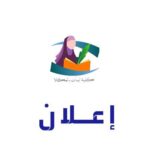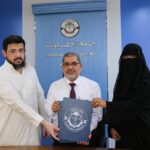قسم اللغة الإنجليزية
النبذة التعريفية عن اللغة الانجليزية
تأسس القسم بالتزامن مع قسم الدراسات الإسلامية في العام الجامعي 2000/2001، ويمنح القسم درجة البكالوريوس في علوم اللغة الإنجليزية وآدابها. ويستهدف القسم امتلاك الدارسات المعارف والمهارات اللغوية في مجال التخصص، بما يمكنهن من الاندماج في سوق العمل، كما يسعى القسم عن طريق خريجاته إلى تقديم الخدمة للمجتمع المحلي بإقامة الدورات التأهيلية القصيرة في مهارات اللغة الإنجليزية وتدريسها.
مدة الدراسة في القسم أربع سنوات أكاديمية (ثمانية فصول دراسية)، وقد تم تخريج ثلاث عشرة دفعة إلى العام الجامعي 2015/ 2016. ويبلغ عدد طالبات القسم في العام الجامعي 2016/2017 (235) طالبة في المستويات الأربعة.
الرسالة
الرؤية
الأهداف
- تصميم وإدارة مساقات دراسية في اللغة الإنجليزية.
- تزويد القطاعين العام والخاص بخريجات مؤهلات في مجال الترجمة، بالإضافة إلى تقديم الخدمات اللغوية للمجتمع.
- إعداد وتأهيل الطالبات لتدريس اللغة الإنجليزية في المدارس الإعدادية والثانوية.
- توطيد العلاقات مع الأقسام والمؤسسات الأخرى؛ لتبادل الأفكار والخبرات في مجال اللغة الإنجليزية.
البرامج العلمية
الخطة الدراسية لقسم اللـغة الإنـجـلـيـزية
برنامج بكالوريوس في لغة إنجليزية
مجمل الساعات المعتمدة للتخرج ونسبتها المئوية:
| طبيعة المقررات | الساعات المعتمدة | نسبتها المئوية |
| متطلبات الجامعة | 16 | 12% |
| متطلبات الكلية | 6 | 4% |
| مساقات التخصص | 117 | 84% |
| المجموع | 139 | 100% |
| المستوى الدراسي الأول | |||||||||||||
| الفصل الدراسي الأول | الفصل الدراسي الثاني | ||||||||||||
| م | الرمز | إسم المقرر | الساعات المعتمدة | طبيعة المقرر | م | الرمز | إسم المقرر | الساعات المعتمدة | طبيعة المقرر | ||||
| ن | ع | مج | ن | ع | مج | ||||||||
| 1 | عرب 111 | لغة عربية 1 | 2 | – | 2 | متطلب جامعة | 1 | عرب 121 | لغة عربية 2 | 2 | – | 2 | متطلب جامعة |
| 2 | نجل 112 | لغة انجليزية 1 | 2 | – | 2 | متطلب جامعة | 2 | نجل 122 | لغة انجليزية 2 | 2 | – | 2 | متطلب جامعة |
| 3 | سلم 113 | ثقافة إسلامية 1 | 2 | – | 2 | متطلب جامعة | 3 | سلم 123 | ثقافة إسلامية 2 | 2 | – | 2 | متطلب جامعة |
| 4 | عال 114 | مهارات الحاسوب | 1 | 1 | 2 | متطلب جامعة | 4 | نجل 124 | Grammar 2 | 3 | – | 3 | متطلب قسم |
| 5 | نجل 115 | Grammar 1 | 3 | – | 3 | متطلب قسم | 5 | نجل 125 | Reading 2 | 3 | – | 3 | متطلب قسم |
| 6 | نجل 116 | Reading 1 | 3 | – | 3 | متطلب قسم | 6 | نجل 126 | Writing 1 | 3 | – | 3 | متطلب قسم |
| 7 | نجل 117 | Speaking & Listening | 3 | – | 3 | متطلب قسم | 7 | نجل 127 | Conversation 1 | 3 | – | 3 | متطلب قسم |
| إجمالي ساعات الفصل
|
17 | إجمالي ساعات الفصل | 18 | ||||||||||
| المستوى الدراسي الثاني | |||||||||||||
| الفصل الدراسي الأول | الفصل الدراسي الثاني | ||||||||||||
| م | الرمز | إسم المقرر | الساعات المعتمدة | طبيعة المقرر | م | الرمز | إسم المقرر | الساعات المعتمدة | طبيعة المقرر | ||||
| ن | ع | مج | ن | ع | مج | ||||||||
| 1 | فن 211 | مهارات يدوية | 1 | 1 | 2 | متطلب كلية | 1 | اجت 221 | مهارات الاتصال | 2 | – | 2 | متطلب كلية |
| 2 | سلم 212 | فقه الأسرة واحكامها | 2 | – | 2 | متطلب كلية | 2 | نجل 222 | Vocabulary Building | 3 | – | 3 | متطلب قسم |
| 3 | نجل 213 | Grammar 3 | 3 | – | 3 | متطلب قسم | 3 | نجل 223 | Elizabethan Drama | 3 | – | 3 | متطلب قسم |
| 4 | نجل 214 | Survey of British Lit. | 3 | – | 3 | متطلب قسم | 4 | نجل 224 | Introduction to linguistics | 3 | – | 3 | متطلب قسم |
| 5 | نجل 215 | Writing 2 | 3 | – | 3 | متطلب قسم | 5 | نجل 225 | Study Skills | 3 | – | 3 |
متطلب قسم |
| 6 | نجل 216 | Conversation 2 | 3 | – | 3 |
متطلب قسم |
6 | نجل 226 | Conversation 3 | 3 | – | 3 | متطلب قسم |
| إجمالي ساعات الفصل | 16 | إجمالي ساعات الفصل | 17 | ||||||||||
| المستوى الدراسي الثالث | |||||||||||||
| الفصل الدراسي الأول | الفصل الدراسي الثاني | ||||||||||||
| م | الرمز | إسم المقرر | الساعات المعتمدة | طبيعة المقرر | م | الرمز | إسم المقرر | الساعات المعتمدة | طبيعة المقرر | ||||
| ن | ع | مج | ن | ع | مج | ||||||||
| 1 | راض 311 | أسس تربية الطفل | 2 | – | 2 | متطلب كلية | 1 | نجل 321 | Semantics | 3 | – | 3 | متطلب قسم |
| 2 | نجل 312 | 18th and 19th Century Novel | 3 | – | 3 | متطلب قسم | 2 | نجل 322 | Literary Appreciation | 3 | – | 3 | متطلب قسم |
| 3 | نجل 313 | Pre-Romantic and Romantic Poetry | 3 | – | 3 | متطلب قسم | 3 | نجل 323 | Syntax | 3 | – | 3 | متطلب قسم |
| 4 | نجل 314 | Phonetics & Phonology | 3 | – | 3 | متطلب قسم | 4 | نجل 324 | Translation 1 | 3 | – | 3 | متطلب قسم |
| 5 | نجل 315 | Applied Linguistics | 3 | – | 3 | متطلب قسم | 5 | نجل 325 | Non-fiction Prose | 3 | – | 3 | متطلب قسم |
| 6 | نجل 316 | Morphology | 3 | – | 3 | متطلب قسم | 6 | نجل 326 | Methods in ELT | 3 | – | 3 | متطلب قسم |
| 7 | نجل 327 | Basics of Scientific Research | 3 | – | 3 | متطلب قسم | |||||||
| إجمالي ساعات الفصل | 17 | إجمالي ساعات الفصل | 21 | ||||||||||
| المستوى الدراسي الرابع | |||||||||||||
| الفصل الدراسي الأول | الفصل الدراسي الثاني | ||||||||||||
| م | الرمز | إسم المقرر | الساعات المعتمدة | طبيعة المقرر | م | الرمز | إسم المقرر | الساعات المعتمدة | طبيعة المقرر | ||||
| ن | ع | مج | ن | ع | مج | ||||||||
| 1 | نجل 411 | Practical Criticism | 3 | – | 3 | متطلب قسم | 1 | نجل 421 | Translation 3 | 3 | – | 3 | متطلب قسم |
| 2 | نجل 412 | Modern American Literature | 3 | – | 3 | متطلب قسم | 2 | نجل 422 | 20th Century Novel | 3 | – | 3 | متطلب قسم |
| 3 | نجل 413 | 20th Century Poetry | 3 | – | 3 | متطلب قسم | 3 | نجل 423 | 20th Century Drama | 3 | – | 3 | متطلب قسم |
| 4 | نجل 414 | Translation 2 | 3 | – | 3 | متطلب قسم | 4 | نجل 424 | Discourse Analysis | 3 | – | 3 | متطلب قسم |
| 5 | نجل 415 | Academic Writing | 3 | – | 3 | متطلب قسم | 5 | نجل 425 | Project Writing | 3 | – | 3 | متطلب قسم |
| 6 | نجل 416 | Practical Work | 3 | – | 3 | متطلب قسم | 6 | ||||||
| إجمالي ساعات الفصل | 18 | إجمالي ساعات الفصل | 15 | ||||||||||





